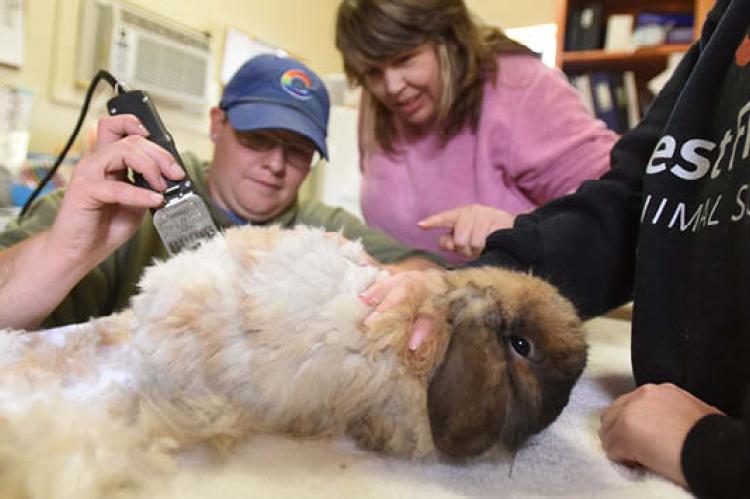Rabbit Grooming: Brushing, Nail Trims, and More

If you have a pet bunny, you will need to undertake some rabbit grooming procedures. These include rabbit nail trims, cleaning soiled areas of the coat, and regular brushing. Here are the basics to know about rabbit grooming.
How often should I brush my rabbit?
Because of their constant shedding, rabbits should be brushed at least weekly. Bunnies can get intestinal blockages from ingesting fur as they groom themselves or their companions, so it's important to regularly brush out the loose fur. Unlike cats, rabbits cannot vomit up fur via hairballs, so it gets stuck internally.
You will have to brush daily during heavy sheds. Rabbits shed in different ways: Some take a couple of weeks or more to lose their old coat, while others shed their old coat in just a few days. Loose hair can often be removed by gently plucking it out with your fingers. Fine-toothed flea combs made for cats also work well to comb out rabbit hair.
Furthermore, certain types of rabbits need more frequent grooming than others. Lionhead, angora, and other long-haired rabbits require much more attention in the grooming department than short-haired rabbits. Long-haired bunnies should be groomed daily to prevent matting of the fur and hairballs.
How to groom a bunny
Pet rabbits vary in their affinity for grooming — some like it; some don’t. Bunnies have thin, sensitive skin, so you’ll want to use gentle strokes when grooming. You can use the soft brushes sold for cats.
Grooming provides an excellent opportunity for you to give your pet rabbit a quick overall checkup. You should check the teeth for misalignment, the eyes and nose for any discharge, and the condition of the fur and skin. Check also for mats and “poopy bottom” (fecal matter stuck to the rear end).
Bald spots on rabbits can occur when they are shedding, but the spots also might be an indication of mites if your bunny picks at them or you see dandruff-like flakes when the hair is pulled out. Consult your veterinarian if you are unsure.
Rabbit Health Check: Signs of a Healthy Bunny
Is it OK to bathe a rabbit?
Rabbits are naturally very clean and do not need baths unless they are incontinent or prone to poopy bottom. If you do need to bathe your bunny, use only water or a gentle rabbit or kitten shampoo. Don’t ever immerse your bunny completely in water — bathe only the soiled area.
Many bunnies squirm quite a bit during bathing, so you might want to have another person there to assist you in holding the rabbit. Towel-dry the rabbit, and use a hairdryer (set to warm, not hot) if necessary.
How to trim a rabbit's nails
A rabbit’s nails can grow to be very long and sharp, which can be uncomfortable for both you and the rabbit. Check the nails at least every four to six weeks. You can trim your rabbit's nails with a guillotine-type nail clipper — the type made for cats and birds, available from most pet supply stores.
Wrapping the bunny in a towel can help to keep them calm and prevent injury from kicking. Try holding the bunny on their back with their head tucked into the crook of your elbow.
If your rabbit has light-colored nails, the quick (the portion of the nail containing blood) is highly visible, making the nails very easy to trim. Just clip the nail right before the quick but not too close. Dark-colored nails, of course, make it more difficult to see the quick. Try shining a penlight through the nail.
People are often afraid to trim their rabbits' nails for fear that they will cut the quick and draw blood. If bleeding occurs, it can be stopped by one of the following methods:
- Apply flour to the area by dabbing it on with your fingers and applying pressure. The flour will help clot the blood.
- Apply pressure to the nail with a cotton ball.
- Use styptic powder (one brand is Kwik Stop), available at most pet supply stores. Always have this on hand if you plan to trim your bunny’s nails.
Can you declaw a rabbit?
Never declaw a rabbit. It is not recommended for rabbits and is also unsafe, inhumane, and totally unnecessary. If you're not able to trim your rabbit's nails on your own, your veterinary clinic can do it for you or recommend other local options.